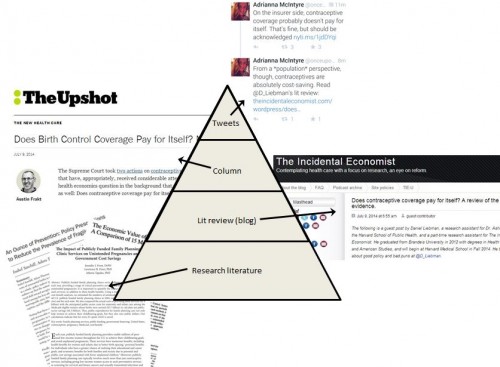Along with many others, I've argued for years that journal publication is an inadequate dissemination strategy. Blogging about the work can help, but that's not all one could do. What is the most one could reasonably do to disseminate one's work or that of one's field?
The answer to that question depends on the assets one has to deploy. For my part, I can tweet, blog, write a piece for a major media company, and/or facilitate others doing so. My full dissemination strategy would include all these approaches. There's a nice way to organize them to convey how they relate to one-another, and how they work together to help a diverse audience find all the information they want and are able to handle, as shown and described below.
At the top (though we could turn it upside down), there are tweets and their cousins, Facebook status updates and the like. These have low information content, as conveyed by the small area they occupy at the top of the chart. But, they also have the potential for the widest reach, in general. If written well enough (which is not hard), they're easily understandable and shareable, with modification if one wishes. Most anyone can tweet and tweet well (or update a Facebook status). It's how things "go viral," to any degree.
But to what should one link in a tweet? Certainly one could link to a journal article one on the issue or point one is attempting to promote, but that's not going to go very far. A journal article is often literally inaccessible by being gated (OK, anyone can pay the ~$35, but nobody will) or what amounts to the same thing—written in technical language and way too long and (I'm sorry to say) boring for all but highly motivated scholars to read.
No, ideally one should link to a short summary that puts the work in the relevant policy or social context. That's what people most want to know. What's the point? Why should I care? Why is this important right now? And, yeah, how will this help me win an argument with my crazy uncle?
The next level down the pyramid, to which a tweet might ideally link, is an online column. It's far longer than a tweet: more information, but still digestible in a few minutes and by a non-expert audience. About 700 words is near ideal. It makes the substantive policy or social point, leaning on evidence (one hopes), but without saying a great deal about that evidence, though more than a tweet, clearly. Most people who don't care to delve deeply into the evidence, but want to know its social import, will stop here. Dissemination reach can be large (e.g., if the column is in a major publication, and in that case, the reach could exceed that of tweets).
That column could simply reference specific research papers. But, in my view, a more compelling, evidence-based argument is based on something like a comprehensive review of the evidence. So, the next level down is a literature review. The column might reference this. It's all about the evidence, but in summary form and organized to help the reader understand it in total. It has a lot of content: it could be well over 1,000 words long, and often much longer than that. It could attempt some translation of that evidence into language more accessible to a wider audience, particularly if it's on a blog. For the vast majority of people interested in evidence, this is the last stop. Reach will almost surely be less than a major-media column or tweets.
Finally, there's the literature itself, upon which the literature review obviously relies. It's voluminous, and not necessary organized in any coherent way. Only experts tread here, so reach is low beyond the field. But the literature is the foundation. Without it, nothing above follows: no evidence-based lit review, column, or tweets. It's the fundamental product, but it can't reach its full potential without help from other dissemination approaches.
I've deployed this hierarchy of dissemination tactics before, sometimes with the help of colleagues. (And, to be sure, I'm not the only one tweeting about my columns, posts, and literature.) For example, last week's focus on the cost-effectiveness of contraception used all levels of the hierarchy, as illustrated below: Adrianna McIntyre (and others, including myself, of course) tweeted, I wrote a New York Times' Upshot column, Daniel Liebman wrote a literature review for The Incidental Economist, and, of course, the research base was already in place.
Of course there are other dissemination tactics. Aaron puts out some amazing Healthcare Triage videos on evidence. Other organizations would write reports, convene meetings, call policymakers and stakeholders, and so forth. Some write books, give keynote addresses before large audiences, ... You get the idea.
It's worth thinking about how the dissemination tactics available to you or your organization fit together and work in concert. Viewing and using them as disjoint tools may not maximize results.
Acknowledgement: I thank Bill Gardner for his email feedback on my early thoughts that led to this post.
Austin B. Frakt, PhD, is a health economist with the Department of Veterans Affairs and an associate professor at Boston University’s School of Medicine and School of Public Health. He blogs about health economics and policy at The Incidental Economist and tweets at @afrakt. The views expressed in this post are that of the author and do not necessarily reflect the position of the Department of Veterans Affairs or Boston University.

